
Porcelain is a ceramic material made by heating substances, generally including materials such as kaolinite, in a kiln to temperatures between 1,200 and 1,400 °C. The strength, and translucence of porcelain, relative to other types of pottery, arises mainly from vitrification and formation of the mineral mullite within the body at these high temperatures. Though definitions vary, porcelain can be divided into three main categories: hard-paste, soft-paste and bone china. The category that an object belongs to depends on the composition of the paste used to make the body of the porcelain object and the firing conditions.
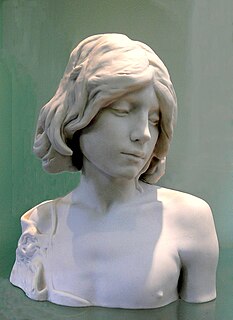
Biscuit porcelain, bisque porcelain or bisque is unglazed, white porcelain treated as a final product, with a matte appearance and texture to the touch. It has been widely used in European pottery, mainly for sculptural and decorative objects that are not tableware and so do not need a glaze for protection.
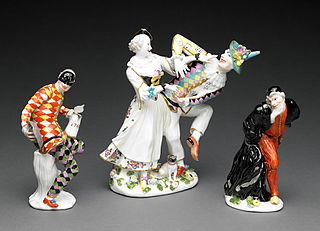
Meissen porcelain or Meissen china was the first European hard-paste porcelain. Early experiments were done in 1708 by Ehrenfried Walther von Tschirnhaus. After his death that October, Johann Friedrich Böttger continued von Tschirnhaus's work and brought this type of porcelain to the market, financed by Augustus the Strong, King of Poland and Elector of Saxony. The production of porcelain in the royal factory at Meissen, near Dresden, started in 1710 and attracted artists and artisans to establish, arguably, the most famous porcelain manufacturer known throughout the world. Its signature logo, the crossed swords, was introduced in 1720 to protect its production; the mark of the swords is reportedly one of the oldest trademarks in existence. Dresden porcelain was once the usual term for these wares, until the Oberlandesgericht decided in favour of the Saxon Porcelain Manufactory Dresden, which alone was then allowed to use the name Dresden Porcelain.

The Manufacture nationale de Sèvres is one of the principal European porcelain factories. It is located in Sèvres, Hauts-de-Seine, France. It is the continuation of Vincennes porcelain, founded in 1740, which moved to Sèvres in 1756. It has been owned by the French crown or government since 1759, and has always maintained the highest standards of quality. Almost immediately, it replaced Meissen porcelain as the standard-setter among European porcelain factories, retaining this position until at least the 19th century.

Museo di Capodimonte is an art museum located in the Palace of Capodimonte, a grand Bourbon palazzo in Naples, Italy. The museum is the prime repository of Neapolitan painting and decorative art, with several important works from other Italian schools of painting, and some important ancient Roman sculptures. It is one of the largest museums in Italy. The museum was inaugurated in 1957.

Maria Amalia of Saxony was a princess of Poland and Saxony, Queen consort of Naples and Sicily from 1738 till 1759 and then Queen consort of Spain by marriage to Charles III of Spain, from 1759 until her death in 1760. The arranged marriage produced many children who survived into adulthood, including Charles IV of Spain. A popular consort, she oversaw the construction of the Caserta Palace outside Naples as well as various other projects, and she is known for her influence upon the affairs of state.

Capodimonte porcelain is porcelain created by the Capodimonte porcelain manufactory, which operated in Naples, Italy, between 1743 and 1759. Capodimonte is the most outstanding factory for early Italian porcelain, the Doccia porcelain of Florence being the other main Italian factory. Capodimonte is most famous for its moulded figurines.

The Doccia porcelain manufactory, at Doccia, a frazione of Sesto Fiorentino, near Florence, was in theory founded in 1735 by marchese Carlo Ginori near his villa, though it does not appear to have produced wares for sale until 1746. It has remained the most important Italian porcelain factory ever since.
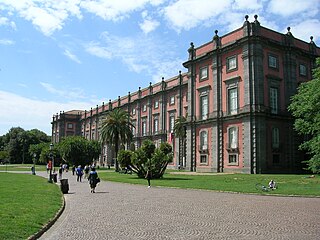
The Royal Palace of Capodimonte is a large palazzo in Naples, Italy. It was formerly the summer residence and hunting lodge of the Bourbon kings of the Two Sicilies, one of the two royal palaces in Naples. Today, it comprises the National Museum of Capodimonte and the Royal Forest. The palace was constructed on its somewhat cooler hilltop location just outside the city, with urban Naples ultimately expanding around it.

The city of Rouen, Normandy has been a centre for the production of faience or tin-glazed earthenware pottery, since at least the 1540s. Unlike Nevers faience, where the earliest potters were immigrants from Italy, who at first continued to make wares in Italian maiolica styles with Italian methods, Rouen faience was essentially French in inspiration, though later influenced by East Asian porcelain. As at Nevers, a number of styles were developed and several were made at the same periods.
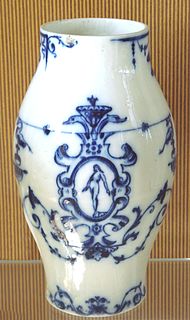
Rouen porcelain is soft-paste porcelain made in the city of Rouen, Normandy, France, during a brief period from about 1673 to 1696. It was the earliest French porcelain, but was probably never made on a commercial basis; only nine pieces are now thought to survive.

The Royal Porcelain Factory in Berlin, also known as the Royal Porcelain Manufactory Berlin and whose products are generally called Berlin porcelain, was founded in 1763 by King Frederick II of Prussia. Its actual origins, however, lie in three private enterprises which, under crown patronage, were trying to establish the production of "white gold" in Berlin from the mid-18th century onwards.

Real Fábrica del Buen Retiro was a porcelain manufacturing factory in Spain. It was located in Madrid's Parque del Buen Retiro, Madrid on a site near the Fuente del Ángel Caído.
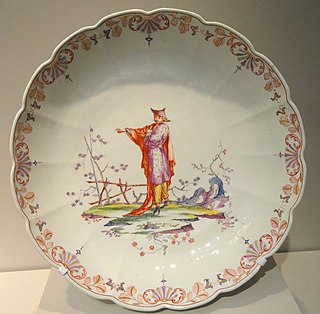
Vienna porcelain is the product of the Vienna Porcelain Manufactory, a porcelain manufacturer in Alsergrund in Vienna, Austria. It was founded in 1718 and continued until 1864.

Ludwigsburg porcelain is porcelain made at the Ludwigsburg Porcelain Manufactory founded by Charles Eugene, Duke of Württemberg, on 5 April 1758 by decree as the Herzoglich-ächte Porcelaine-Fabrique. It operated from the grounds of the Baroque Ludwigsburg Palace. After a first two decades that were artistically, but not financially, successful, the factory went into a slow decline and was closed in 1824. Much later a series of other companies used the Ludwigsburg name, but the last production was in 2010.

The Louis XIV style or Louis Quatorze, also called French classicism, was the style of architecture and decorative arts intended to glorify King Louis XIV and his reign. It featured majesty, harmony and regularity. It became the official style during the reign of Louis XIV (1643–1715), imposed upon artists by the newly established Académie royale de peinture et de sculpture and the Académie royale d'architecture. It had an important influence upon the architecture of other European monarchs, from Frederick the Great of Prussia to Peter the Great of Russia. Major architects of the period included François Mansart, Jules Hardouin Mansart, Robert de Cotte, Pierre Le Muet, Claude Perrault, and Louis Le Vau. Major monuments included the Palace of Versailles, the Grand Trianon at Versailles, and the Church of Les Invalides (1675–91).
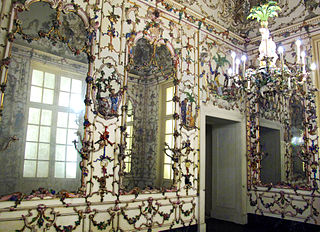
The Porcelain boudoir of Maria Amalia of Saxony is a rococo interior now located in the Palace of Capodimonte in Naples. It was originally made for the Palace of Portici in 1757–59, but has now been moved to the Capodimonte Palace.It is named after Maria Amalia of Saxony, queen of Naples. It consists of white porcelain panels decorated in high relief with festoons and genre scenes, drawing on the Chinoiserie popular at the time. It was designed by Giuseppe Gricci and produced in the Royal Porcelain Factory of Capodimonte, founded by Maria Amalia and her husband Charles of Bourbon in 1743.
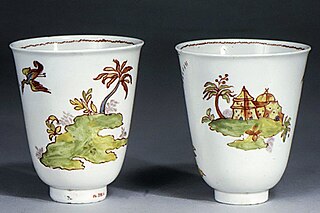
Vezzi porcelain is porcelain made by the Vezzi porcelain factory in Venice, Italy, established in 1720 by the Vezzi family. It was the first porcelain factory in Italy, after the experimental Medici porcelain of the 16th century. It operated only until 1727, so surviving pieces are few, probably fewer than 200. It made "true" hard-paste porcelain, and was only the third factory in Europe to do so, hiring technicians from Meissen porcelain and Vienna porcelain, the first two makers.

Cozzi porcelain is porcelain made by the Cozzi factory in Venice, which operated between 1764 and 1812. Production included sculptural figurines, mostly left in plain glazed white, and tableware, mostly painted with floral designs or with figures in landscapes and buildings, in "bright but rough" colours. They were rather derivative, drawing from Meissen porcelain in particular in the early years.

Le Nove porcelain was made in the 18th century in the town now called Nove, near Bassano, then in the Republic of Venice's mainland territories, the terrafirma. It was made at a factory owned by Pasquale Antonibon, who was already making fine maiolica in fashionable styles, which continued to be made alongside the porcelain. Production of porcelain began in 1762 and ended when Antonibon died in 1773. But it resumed in 1781, when Francisco Parolin leased the factory for twenty years in a partnership with the Antonibons, known as the "Parolin period". This lasted until 1802. Production of porcelain continued intermittently until 1835.




















